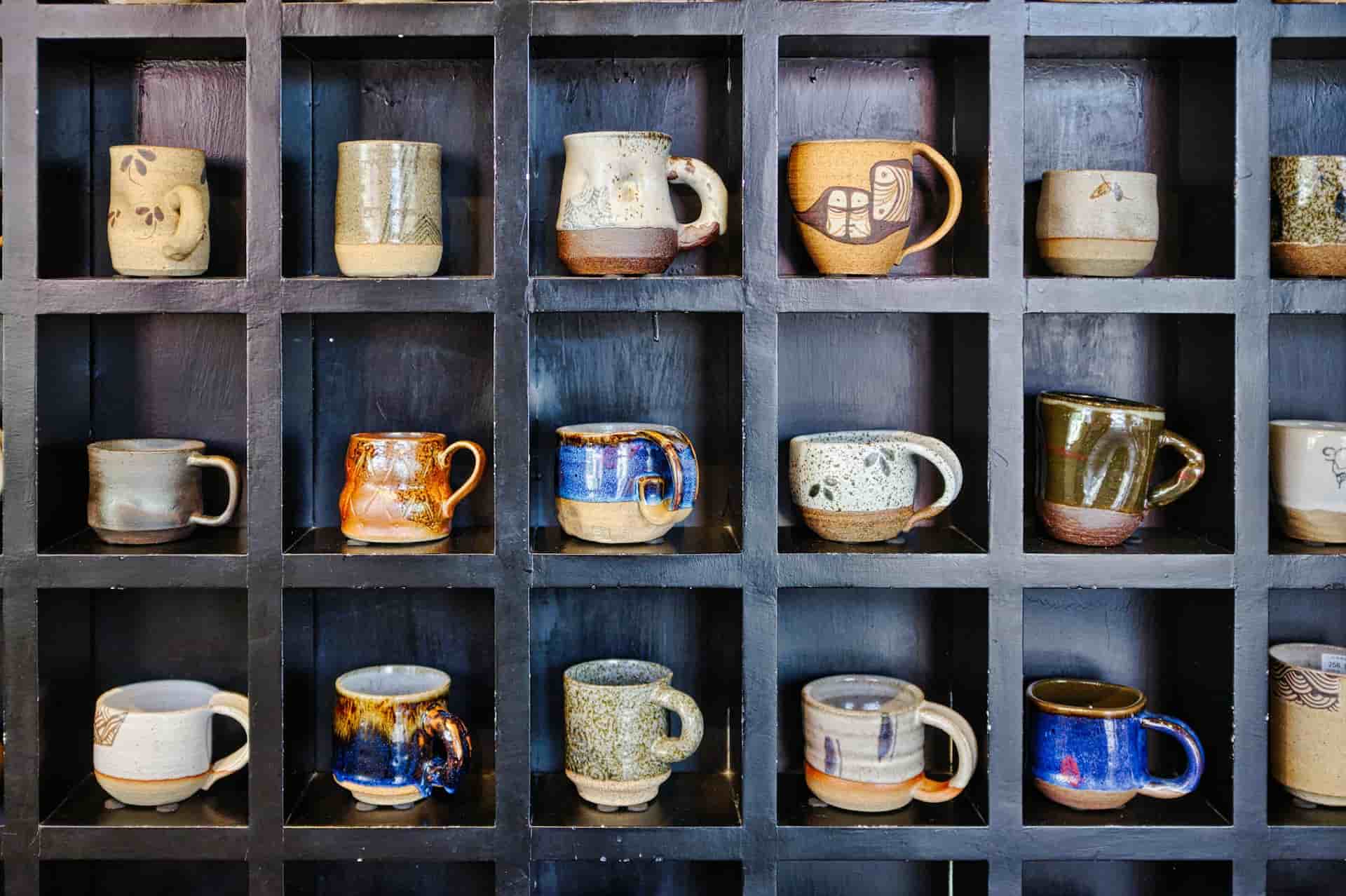When it comes to coffee mugs, the material matters as much as the brew itself.
Selecting the right material for your coffee mug is not just a matter of aesthetics; it significantly influences your coffee-drinking experience.
From the classic charm of ceramic to the sleek durability of stainless steel, each material offers unique benefits and drawbacks.
In this guide, we’ll delve into the most common materials used in coffee mugs, helping you make an informed choice that enhances every sip of your favorite coffee.
1. Ceramic Mugs
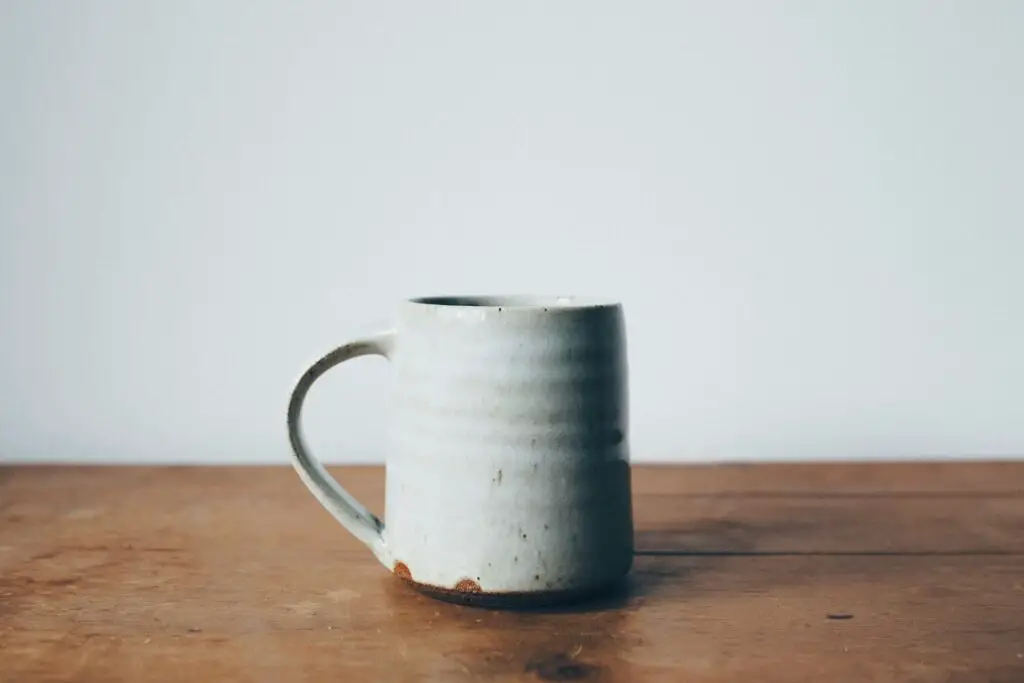
Ceramic mugs are a staple in the coffee world, beloved for their perfect balance of practicality and style.
Let’s break down what makes them a go-to choice for many:
Advantages
Affordability
One of the biggest draws of ceramic mugs is their friendly price tag.
They offer great value, ensuring you don’t have to splurge to enjoy your daily coffee ritual.
Availability
You’ll find ceramic mugs everywhere, from your local store to online shops.
Their widespread availability means you’re never far from finding your next favorite mug.
Design Diversity
Whether you prefer simple, elegant designs or vibrant, artistic patterns, ceramic mugs come in an array of styles to match your personality and décor.
Taste Preservation
Ceramic doesn’t interfere with the flavor of your coffee.
It ensures that each sip you take is as the brewer intended, pure and unaltered.
Disadvantages
Heat Retention
If you like your coffee hot for longer, ceramic might not be your best bet.
These mugs don’t hold heat as well as other materials, so your drink might cool down quicker than you’d like.
Fragility
Ceramic mugs can be delicate.
A slip from your hand might lead to a crack or a break, so they require a bit of careful handling.
Staining Over Time
Love your coffee strong and dark? Ceramic mugs can show evidence of your coffee habits over time, as they are prone to staining, especially with frequent use.
Who Should Use Ceramic Mugs
Ceramic mugs are a fantastic, budget-friendly option for everyday coffee drinking, especially if you’re after something that looks good and keeps your coffee’s taste true.
Just remember to handle them with care and give them a good scrub now and then to keep them looking their best.
2. Porcelain Mugs
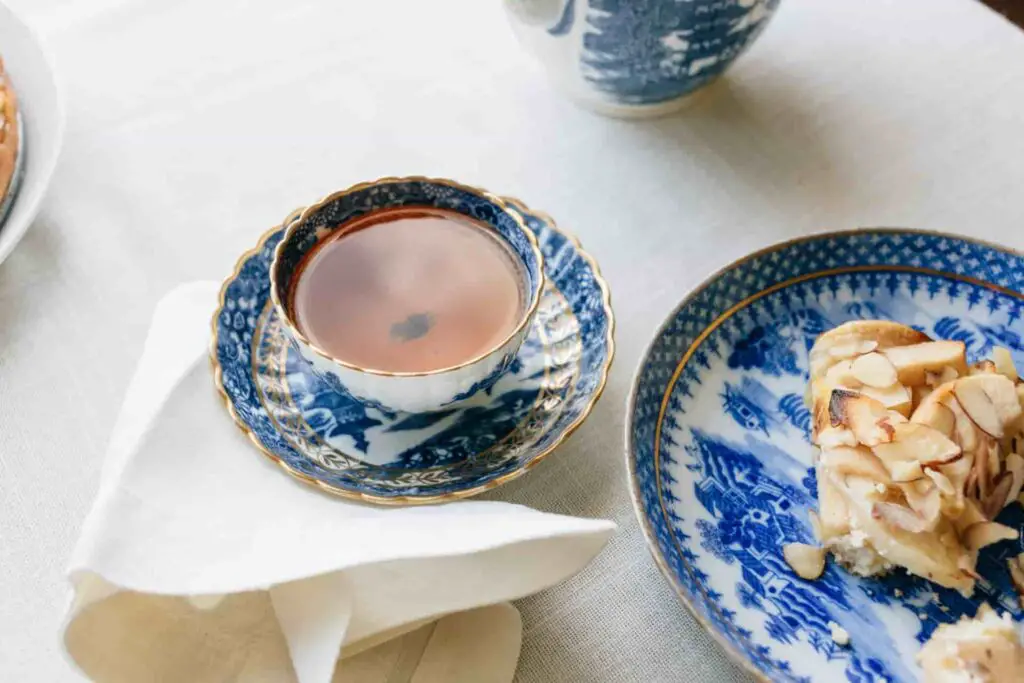
Porcelain mugs are more than just a coffee container; they’re a statement of elegance.
Let’s dive into what sets them apart:
Advantages
Elegance Personified
Porcelain mugs are the epitome of sophistication.
Their refined appearance adds a touch of class to your coffee moments.
Light as a Feather
These mugs are surprisingly lightweight, making them a pleasure to hold, even for those leisurely coffee sessions.
Resists Stains and Odors
Thanks to their non-porous nature, porcelain mugs don’t hold onto stains or odors.
Your coffee tastes as fresh and pure as it should, every time.
Disadvantages
Handle with Care
Porcelain’s elegance comes with a caveat – it’s more fragile than ceramic.
A little bump or drop can lead to chips or cracks, so it’s best to handle them gently.
A Pricier Choice
Beauty and quality come at a cost.
Porcelain mugs can be on the pricier side, which might not be ideal if you’re looking for a budget-friendly option.
Who Should Use Porcelain Mugs
Porcelain mugs are perfect for those who value the finer things in life and don’t mind spending a bit extra for that premium coffee experience.
They’re ideal for serene, sit-down coffee breaks where you can appreciate both the brew and the beauty of the mug.
Just remember, they need a bit of extra love and care to maintain their pristine condition.
3. Glass Mugs

Glass mugs bring a unique charm to your coffee table, combining visual appeal with functional simplicity.
Let’s explore what makes them special:
Advantages
Visual Delight
The clear, transparent nature of glass mugs adds an aesthetic appeal to your coffee routine.
Watching your coffee swirl and steam in a glass mug is a small daily pleasure.
See Your Brew
For those who love the visual aspect of coffee, glass mugs are perfect.
They allow you to appreciate the color and texture of your coffee, enhancing the overall experience.
Flavor Integrity
Glass is taste-neutral.
It doesn’t impart any additional flavors to your coffee, ensuring that you taste your brew and nothing else.
Disadvantages
Quick to Cool
Glass mugs aren’t the best at keeping your coffee hot.
If you’re a slow sipper, you might find your coffee cooling down faster than you’d like.
Handle with Care
Glass is delicate.
A little knock or a drop, and you might be left with shattered pieces.
They require gentle handling and careful storage.
Not for the Great Outdoors
If you’re a fan of taking your coffee on hikes or picnics, glass mugs might not be your best companion.
Their fragility makes them less suited for outdoor adventures.
Who Should Use Glass Mugs
In short, glass mugs are perfect for those who value the beauty of their brew and enjoy their coffee in a calm, indoor setting.
They offer a pure and unaltered coffee experience, as long as you’re okay with being a bit careful around them.
Just remember, they’re more about leisurely sips in a cozy corner than rugged, outdoor coffee breaks.
4. Stainless Steel Mugs
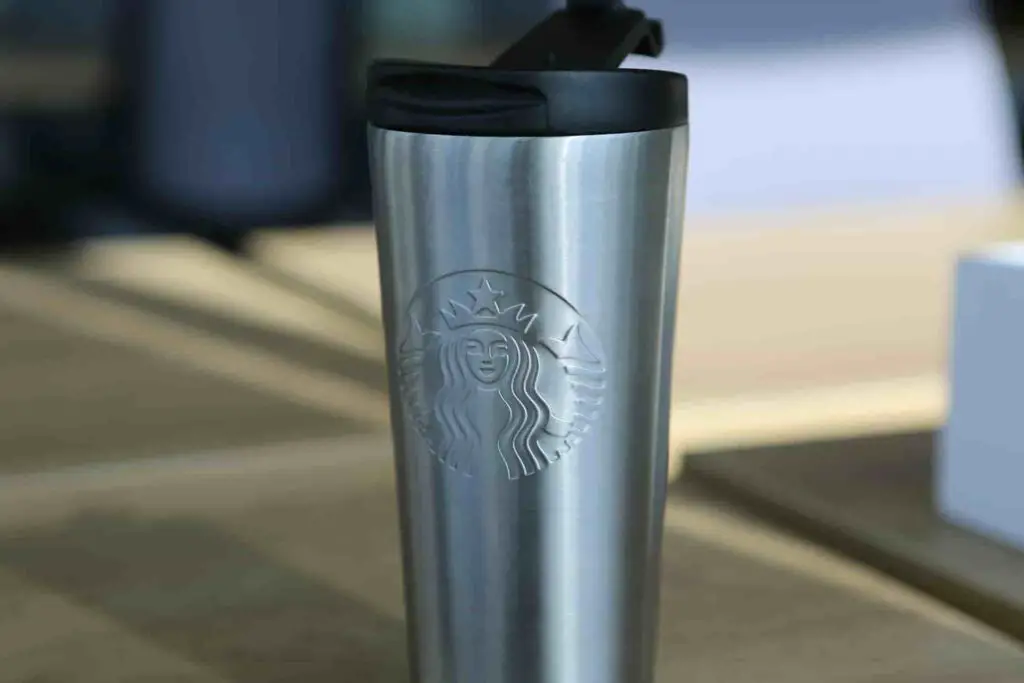
Stainless steel mugs are the tough, reliable choice for coffee lovers on the go.
Let’s delve into their practicality:
Advantages
Keeps Coffee Hot
One of the biggest perks of stainless steel mugs is their excellent heat retention.
Your coffee stays hot for hours, making it perfect for long commutes or outdoor adventures.
Built to Last
Durability is a key feature here.
Stainless steel mugs can handle the bumps and drops of daily life without a dent, making them a long-lasting companion.
Travel-Friendly
Their robustness and heat-retaining qualities make stainless steel mugs ideal for travel.
Whether you’re hiking, camping, or just commuting, they’re a reliable choice.
Disadvantages
Taste Factor
Sometimes, stainless steel can impart a slight metallic taste to your coffee, which might not be appealing if you’re particular about your brew’s flavor.
Not for the Coffee Connoisseur
If you’re someone who enjoys savoring the subtle flavors of high-quality coffee, stainless steel might not be the best choice.
The material’s potential to alter taste can overshadow the delicate nuances of your coffee.
Who Should Use Stainless Steel Mugs
Stainless steel mugs are the go-to option for coffee drinkers who prioritize durability and heat retention, especially for those who are always on the move.
They’re not about the leisurely coffee-tasting experience but more about practicality and keeping your coffee warm wherever you go.
However, they might not be the best at preserving the intricate flavors of gourmet coffee.
5. Stoneware Mugs
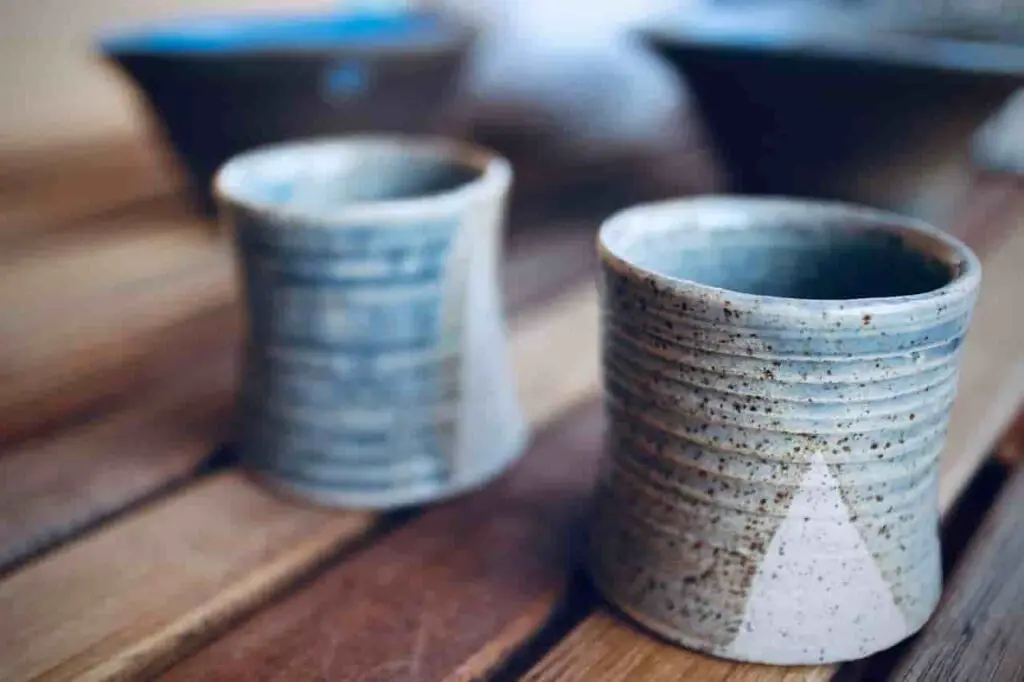
Stoneware mugs are like the cozy, dependable sweaters of the coffee world.
Let’s explore why they’re cherished by many:
Advantages
Tough and Trusty
Stoneware mugs are known for their durability.
They’re made to last, handling daily use with ease.
Keeps Coffee Warm
These mugs are great at retaining heat, ensuring your coffee stays warm for a satisfyingly long time.
Uniquely Yours
Stoneware mugs often come in a variety of unique and artisanal designs.
They add a personal touch to your coffee routine, making each sip a little more special.
Disadvantages
A Bit of a Weight
Stoneware mugs are on the heavier side.
If you like a light mug, these might take some getting used to.
Investment Piece
Quality comes at a price.
Stoneware mugs can be more expensive than your average mug, but for many, the investment is worth it.
Sensitive to Sudden Changes
While sturdy, stoneware mugs don’t take kindly to rapid temperature changes.
Moving from very hot to cold environments too quickly can lead to cracks.
Who Should Use Stoneware Mugs
Stoneware mugs are perfect for those who appreciate a mug that feels substantial and retains heat well.
Their unique designs make them more than just a coffee container; they’re a statement piece.
Just handle them with a bit of care, especially when it comes to temperature changes, and they’ll be a long-lasting part of your coffee experience.
6. Plastic Mugs

Plastic mugs are the go-to for a fuss-free coffee experience.
Let’s take a closer look at what they offer:
Advantages
Light and Easy
One of the biggest draws of plastic mugs is their lightweight nature.
They’re easy to handle, making them a great choice for a quick coffee on the go.
Wallet-Friendly
If you’re looking for an affordable option, plastic mugs are your best bet.
They’re easy on the pocket without compromising on functionality.
Spill-Proof Design
Many plastic mugs come with spill-proof lids, perfect for those bumpy commutes or if you’re prone to the occasional coffee spill.
Disadvantages
TasteMatters
Sometimes, plastic mugs can impart an unwanted flavor to your coffee.
If you’re particular about getting that pure coffee taste, they might not be the best choice.
Eco-Impact
Plastic isn’t the most environmentally friendly material.
If you’re conscious about your ecological footprint, you might want to consider more sustainable options.
Who Should Use Plastic Mugs
Plastic mugs are all about convenience and affordability.
They’re ideal for busy mornings or when you need a coffee companion on the move.
However, if you’re a coffee aficionado who values taste above all or you’re mindful of environmental concerns, you might want to explore other materials.
7. Paper Mugs

Paper mugs are often seen as a quick and eco-conscious option for coffee lovers.
Let’s explore what they have to offer:
Advantages
Light and Handy
One of the biggest pluses of paper mugs is their lightweight nature.
They’re incredibly easy to carry around, making them perfect for events or on-the-go coffee needs.
Recyclable
In today’s eco-aware world, the recyclability of paper mugs is a significant advantage.
They can be easily recycled, reducing environmental impact.
Disadvantages
Single-Use Limitation
Unlike their ceramic or metal counterparts, paper mugs can’t be reused.
This means more waste, even if they are recyclable.
Flavor Influence
Paper mugs can sometimes impart external flavors into your coffee, altering the taste.
This might not be ideal for those who prefer their coffee flavor unadulterated.
Best for Specific Occasions
While they’re not the go-to for daily coffee drinkers, paper mugs are great for parties, events, or even for coffee shops looking for convenient, disposable options.
Who Should Use Paper Mugs
Paper mugs are all about convenience and eco-friendliness.
They’re a great pick for large gatherings or busy coffee shops where quick service and easy cleanup are priorities.
However, for the everyday coffee enthusiast who enjoys savoring their brew, other reusable options might be more suitable.
8. Styrofoam Mugs

Styrofoam mugs are often found in office pantries and quick-service coffee shops.
Let’s take a closer look at their pros and cons:
Advantages
Cost Effective
One of the biggest draws of Styrofoam mugs is their affordability.
They’re a budget-friendly option, especially for large gatherings or businesses.
Keeps Coffee Warm
Surprisingly, Styrofoam is quite good at retaining heat, ensuring your coffee stays hot for a longer duration than you might expect.
Disadvantages
Environmental Concerns
The most significant downside of Styrofoam is its environmental impact.
It’s not biodegradable and can be harmful to wildlife and ecosystems.
Health Questions
There are health concerns associated with Styrofoam, especially when used with hot beverages.
Chemicals can leach into the coffee, potentially posing health risks.
Not Reusable or Recyclable
Unlike paper, Styrofoam mugs can’t be recycled, contributing to landfill waste.
Flavor Impact
Similar to paper mugs, Styrofoam can also impart a slight chemical taste to the coffee, which might affect your drinking experience.
Who Should Choose Styrofoam Mugs
While Styrofoam mugs are a low-cost and heat-efficient option for serving coffee, their environmental and health impacts make them a less desirable choice for those who are eco-conscious or concerned about the purity of their coffee’s flavor.
They might be practical for certain situations, but the downsides are significant enough to consider other alternatives.
Exploring Other Mug Materials
Beyond the usual materials, there’s a world of other materials each bringing its unique charm to your coffee experience.
Let’s dive into some of these alternatives:
Bamboo Mugs
- Pros: Bamboo mugs stand out for their eco-friendliness and lightweight design. They’re great for those seeking a sustainable option.
- Cons: They may not be as durable as other materials and can be sensitive to extreme temperatures.
Enamel Mugs
- Pros: Enamel mugs are known for their vintage appeal and rugged durability, making them ideal for camping or outdoor use.
- Cons: They can chip if dropped and may not retain heat as well as heavier materials.
Silicone Mug
- Pros: Silicone mugs are flexible, often collapsible, and perfect for travel. They’re also microwave and dishwasher-safe.
- Cons: They might not offer the best heat retention and can have a unique feel that some might not prefer.
Wooden Mugs
- Pros: Wooden mugs offer a natural, rustic aesthetic and are typically very durable.
- Cons: They require more care in cleaning and aren’t usually dishwasher-safe. Wood can also alter the taste of your coffee over time.
Bone China Mugs
- Pros: Bone china is lightweight, elegant, and often features intricate designs. It’s great for a sophisticated coffee experience.
- Cons: These mugs can be fragile and are usually on the pricier side.
Copper Mugs
- Pros: Copper mugs are excellent for cold brews, offering superior temperature retention and a stylish look.
- Cons: They’re not ideal for hot beverages and can be expensive. Copper also requires regular maintenance to prevent tarnishing.
A Few of the Worst Materials for Coffee Mugs
While many materials make excellent coffee mugs, some are less ideal due to health, taste, or environmental concerns.
Here’s a look at a few materials that might not be the best choice for your coffee mug:
Cheap Plastic
Lower-quality plastics can be a poor choice for coffee mugs.
They may leach chemicals when exposed to hot liquids, potentially posing health risks.
Additionally, they can absorb flavors and odors, altering the taste of your coffee over time.
Uncoated Metals
Certain metals, like aluminum or uncoated copper, can impart a metallic taste to your coffee.
They can also react with the acidity in coffee, leading to a change in flavor.
Moreover, some metals are not suitable for microwave use, limiting their convenience.
Polystyrene Foam (Styrofoam)
While great for insulation, Styrofoam is not environmentally friendly.
It’s non-biodegradable and can release harmful chemicals, especially when used with hot beverages.
Melamine
Often used in reusable plasticware, melamine can release harmful compounds at high temperatures.
It’s not the safest choice for a material that will be in contact with hot coffee regularly.
Painted or Decorative Mugs with Unsafe Coatings
Some mugs, especially cheaper ones, may have decorative paints or glazes that contain harmful substances like lead or cadmium.
These can leach into your coffee, especially as the mug’s surface wears down over time.
Glass with Poor Heat Resistance
While glass mugs can be great, those not designed to withstand high temperatures can crack easily, posing a safety hazard.
Choosing the Right Mug Material: What to Consider
Personal Taste Preferences
Flavor First
If you’re particular about the taste of your coffee, choose a material that doesn’t alter its flavor.
Ceramic, glass, and porcelain are great for preserving the true taste of your coffee.
Aesthetic Appeal
Love a mug that stands out? Materials like stoneware or bone china offer unique designs.
If you prefer a minimalist look, glass or stainless steel might be up your alley.
Typical Usage Scenarios
At Home
For home use, comfort and heat retention might be your priority.
Ceramic or stoneware mugs, which are great at keeping coffee warm and come in various cozy designs, could be ideal.
On the Go
If you’re always on the move, durability and heat retention are key.
Stainless steel or silicone mugs are practical, durable, and maintain the temperature of your coffee.
In the Office
For office use, you might want something that’s easy to clean and doesn’t stain easily, like porcelain or glass.
Environmental Considerations
Eco-Friendly Options
If you’re environmentally conscious, consider materials like bamboo, which is sustainable, or glass and metal, which are recyclable.
Reducing Waste
Reusable mugs are always a better choice over single-use options like paper or Styrofoam, both for environmental and health reasons.
How the Shape of a Mug Affects Taste
The shape of your coffee mug plays a surprisingly significant role in your coffee’s taste and overall drinking experience.
A mug’s shape can influence the coffee’s aroma, which is a crucial component of its flavor profile.
Wide, open mugs allow more aroma to escape and interact with your senses, enhancing the perceived richness and complexity of the coffee.
The thickness of the mug also affects heat retention, with thicker walls keeping your coffee warm for longer, thereby maintaining its flavor profile.
How the Color of a Mug Affects Taste
The color of your coffee mug can subtly influence your perception of the coffee’s taste, an intriguing interplay of sensory experiences.
Research suggests that the color of the mug can impact how we perceive the flavor and temperature of the coffee.
For instance, coffee served in a white mug is often perceived as more intense and sweet than when served in any other color.
Tips for Taking Care of Your Coffee Mug
Maintaining your coffee mug is key to ensuring it lasts long and continues to be a delightful part of your coffee experience.
Here are some general tips to keep your mugs in great shape:
- Regular Cleaning: Clean your mug after every use to prevent staining and buildup of coffee oils. A quick rinse and a gentle scrub with dish soap usually suffice.
- Avoid Abrasive Scrubbers: For most mug materials, especially those with a glossy finish or delicate designs, use a soft sponge or cloth to clean. Abrasive pads can scratch and damage the surface.
- Handle with Care: Be mindful when placing your mug in the sink or dishwasher. Clanking against other dishes can cause chips or cracks, especially in ceramic or glass mugs.
- Proper Storage: Store your mugs in a dry, secure place. Hanging them by the handle or stacking them properly on a shelf can prevent accidental damage.
- Dealing with Stains: For tough stains, soak the mug in a mixture of warm water and baking soda or vinegar before washing. This is especially effective for materials prone to staining, like ceramic.
- Check Dishwasher Compatibility: Not all mugs are dishwasher safe. Check the manufacturer’s instructions, especially for mugs made of materials like wood, bamboo, or certain metals.
- Avoid Extreme Temperature Changes: Sudden changes from hot to cold can crack some materials like glass or stoneware. Let your mug adjust to room temperature before washing with very hot or cold water.
- Microwave Use: If you use the microwave to reheat coffee, ensure your mug is microwave-safe. Materials like metal or certain plastics are not suitable for microwave use.
Conclusion
The journey to finding your ideal coffee mug is a blend of understanding materials, shapes, colors, and personal preferences.
We’ve explored how different materials from ceramic to bamboo offer unique advantages, whether it’s heat retention, flavor preservation, or environmental friendliness.
The shape and color of a mug can subtly influence your coffee’s taste and temperature perception, adding another layer to your coffee experience.
Our recommendation is to consider your daily coffee routine:
Do you savor your coffee at home, or are you always on the go? Are you a coffee purist focused on flavor, or do you seek a mug that makes a style statement?
Your answers to these questions will guide you to a mug that not only holds your coffee but also enhances your coffee-drinking moments.
Remember, the right mug can turn a daily habit into a cherished ritual.
FAQ’s
What are the safest mug materials for coffee?
The safest materials for coffee mugs are those that don’t leach chemicals into your drink and are stable at high temperatures.
Ceramic, porcelain, glass, and high-quality stainless steel are considered the safest options.
They are non-reactive and don’t impart any flavors or harmful substances into your coffee.
What kind of mug keeps coffee the hottest?
Mugs made from materials with good insulation properties, like double-walled stainless steel or ceramic with thick walls, are best for keeping coffee hot.
Stainless steel, in particular, is excellent for heat retention, making it ideal for those who want their coffee to stay warm for extended periods.
Is a paper coffee cup better than Styrofoam?
From an environmental standpoint, paper cups are generally considered better than Styrofoam (polystyrene) cups.
Paper is biodegradable and more widely recyclable, whereas Styrofoam can take hundreds of years to decompose and is not widely recyclable.
However, in terms of insulation, Styrofoam cups tend to keep coffee hot for longer.
How much does a coffee cup cost?
The cost of a coffee cup varies widely depending on the material, design, and brand.
A basic ceramic or glass mug can cost anywhere from $5 to $20, while designer or artisanal mugs may cost more.
Stainless steel and specialty mugs, like those with temperature control, can range from $15 to over $30.
Will a wooden coffee mug warp in the dishwasher?
Yes, wooden coffee mugs can warp or crack in the dishwasher due to the high heat and prolonged exposure to water.
It’s best to hand wash wooden mugs with mild soap and water and dry them immediately to maintain their shape and longevity.
Always check the manufacturer’s care instructions for the best results.

